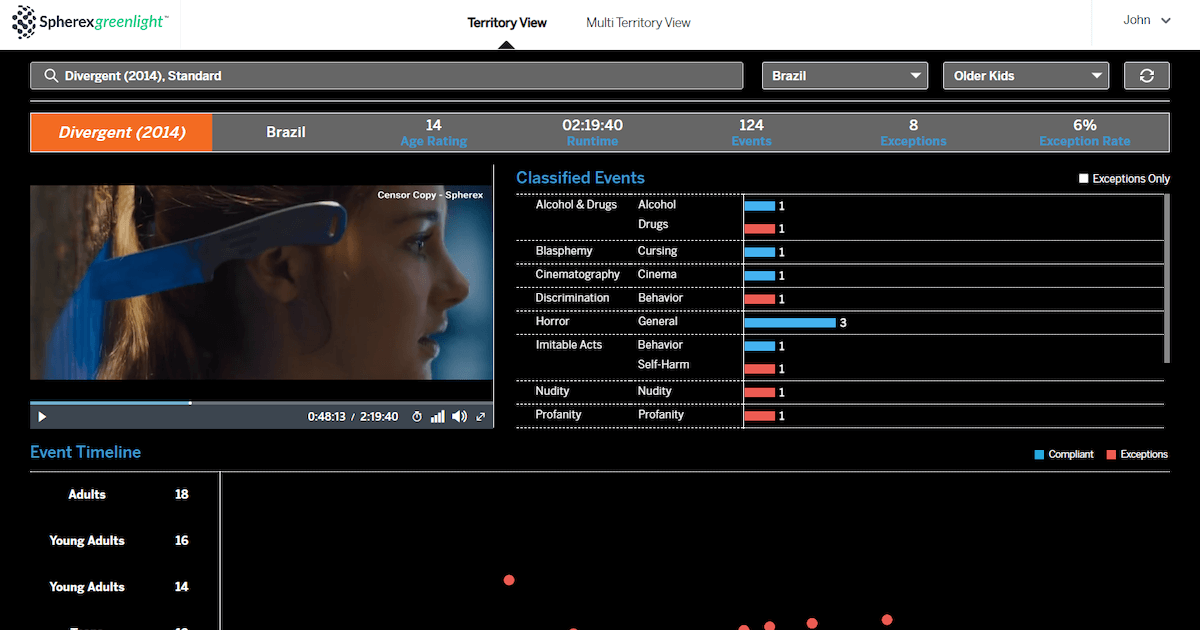Censorship

The French writer Jean-Baptiste Alphonse Karr wrote in 1849 , "the more things change, the more they stay the same." Writing about the social changes occurring in France at the time, his point was that nothing changes without a fundamental shift in knowledge and thinking. Here at Spherex, we closely monitor changes in new legislation, policies, or public sentiment in countries worldwide because it directly impacts a title's age rating , the potential for censorship or unfavorable press, and revenue opportunities. Awareness is the first step in avoiding legal or brand exposure. Since we last wrote on this subject six months ago , some changes have occurred, but much remains the same. Here are recent examples of what we mean. The More Things Change – Malaysia Malaysia's Film Censorship Board (LPF) announced new film and online content ratings in January 2023 that took effect on 1 February 2023. The ratings established five classifications, an addition of two from the previous three: 1. "U" for viewers of all ages 2. "P12" for viewers under 12 years old that required parental guidance (new) 3. "13" for audiences 13 years and older 4. "16" for viewers 16 years and older (new) 5. "18" for viewers 18 and above The changes were a response to content creators expressing that the previous classification system made it impossible to include some scenes without compromising the story. Time will tell how the new system will affect the LPF's view of titles similar to those previously banned , e.g., "Thor: Love and Thunder" and "Lightyear." The first test may be the upcoming Malaysian film " Pulau ," which critics say contains many indecent scenes unsuitable for public viewing . The objectionable scenes include "sexualized kissing" and women wearing bikinis. Some Malaysian officials have already called for it to be banned . The film is scheduled for release next month. The More They Stay the Same – Jordan Netflix, which continues to invest in international content creation, must find a way for local stories to gain global appeal . The company's most-watched title for the past month in Jordan is " Al Hara (The Alleys)." As a locally produced title, the film, while popular with audiences, has been subjected to condemnation by members of the Jordanian Parliament for the inclusion of offensive words and profanity, despite having been approved by Jordan's Royal Film Commission (RFC). The Jordanian Media Authority removed all profanity and scenes that deviated from the values of Jordanian society from the movie before its theatrical release. Netflix’s version restored those scenes, which is the source of controversy. Things Really Don't Change at All – United States From religious beliefs to local traditions to family values to moral standards, ensuring content respects societal norms is a boundary local regulators or censors are keen to safeguard. Sometimes, countries choose to protect these boundaries through legislation when they perceive censorship is being used to compromise the country’s standing in the world or influence their film industry. Last December, the U.S. Congress passed, and the President signed, the " National Defense Authorization Act for Fiscal Year 2023 ." The act prohibits any U.S. federal agency from knowingly supporting the production of any film, television, or other entertainment project explicitly edited to appease Chinese governmental censors. Specifically, Section 1257 of the law states: "None of the funds authorized to be appropriated by this Act may be used to knowingly provide active and direct support to any film, television, or other entertainment project if the Secretary of Defense has demonstrable evidence that the project has complied or is likely to comply with a demand from the Government of the People's Republic of China or the Chinese Communist Party, or an entity under the direction of the People's Republic of China or the Chinese Communist Party, to censor the content of the project in a material manner to advance the national interest of the People's Republic of China." This language was inserted into the law because some members of Congress wanted to codify their displeasure with China's practice of demanding edits of scenes it felt were critical of the country, such as its censorship of the film, " Top Gun: Maverick ," among others. The Media & Entertainment (M&E) industry attempted to remove the language from the bill because it included increased government editorial control over the script. The concern among studios is that this provision will make it more challenging to export titles, thus reducing revenue opportunities for US-produced films. Censorship is happening around the globe, and the extent of its effect can vary widely. It can directly impact how, where, and when stories are told. For those unwilling or unable to make changes, failing to comply with requested or required edits, cuts, bleeps, or blurs will negatively impact the title’s bottom line, regardless of the method or platform. While no one likes changing their story to appease public or political concerns, knowing the issues and possible remedies is the best way to deal with them. Regardless of a title's production stage, Spherex has the cultural and regulatory expertise to assist content creators in navigating this ever-evolving landscape. Contact us today to learn more.

Happy New Year! Everyone at Spherex wishes you and yours a healthy and prosperous 2023. What’s that old saying, “Out with the old, in with the new”? Or maybe it’s, “What’s past is prologue” or “The more things change, the more they stay the same.” Whether your perspective is optimistic or pessimistic, the end of the old year and the start of a new one requires retrospection. Content Censorship Unsurprisingly, Q4 continued the trend of increased censorship of political, religious, culturally critical, and LGBTQ+ content over the first three quarters of 2022, all of 2021 and 2020. Here are a few examples, as reported in Spherex’s World M&E News . Indian regulators question whether the color of a bathing suit insults religious sentiments Myanmar’s censorship board must first approve all foreign film and TV content Russia added a journalist portrayed in the documentary “Navalny” to its “Wanted” list China’s cultural regulations are causing independent filmmakers to look for ways around them with mixed results Pakistan terminates the independence of its Central Board of Film Censors (CBFC) and places it under the political control of the Ministry of Information and Broadcasting The Turkish Culture Ministry demanded its investment back from the producers of an award-winning film after a campaign by conservative media claimed it was “ LGBT propaganda ” Catholic groups in South Africa, Kenya, and Brazil boycotted Netflix over LGBTQ+ content Countries and media companies announce rules or ban generative AI content, including China and Getty Images New content regulations went into effect in Ireland , Singapore , and Jamaica Disney films “Black Panther: Wakanda Forever” and “Black Adam” were banned in China due to the former film’s portrayal of an LGBTQ+ relationship and one of the latter’s lead actors, Pierce Brosnan, past comments regarding the Dalai Lama. External to these actions impacting M&E is the increase of anti-LGBTQ+ rhetoric in the news media around the world, often echoing the opinions of political and religious leaders. From the US to South America to Europe to Africa to Asia and Australia , the increasingly threatening anti-LGBTQ+ commentary and laws will continue to pressure the M&E industry to avoid creating or distributing such content. Thankfully, 2022 was also the year some in the industry began to resist those pressures, some later than others. Even then, those efforts were met with a direct political response intended to punish their perceived non-compliance. Now for the Good News Q4 wasn’t all doom and gloom. The big winners of the quarter, in fact for the entire year, are foreign film and TV titles. During this quarter, they were not only recognized for their quality by being nominated or winning more industry awards than ever before but more were picked up for distribution in the coming year. Thanks to streaming, more were produced and released to international audiences than ever before. Top films from India , South Korea , and Europe have begun to prove audiences are finally overcoming that “1-inch subtitle barrier.” Five foreign titles released in Q4 grossed over $1.06B in box office revenue, four of which were not in the domestic US market. Trade publications worldwide, including the Hollywood Reporter , Variety , and The Guardian (UK), include foreign titles in their “Best of” lists for 2022. A Year to DEI For (Diversity, Equity, and Inclusion) Diversity, equity, and inclusion began to take hold in Hollywood and elsewhere heading into 2022, and there is hope that the trend will continue. Two studies released yesterday (2 Jan 2023) indicate while that trend may have stalled due to the economy, signs of progress and hope are also visible. San Diego State’s study found a 1% decline in the total number of women and people of color (POC) in top creative roles in the 100 top-grossing titles in 2022, but it increased by 1% when looking at the top 250 titles. USC’s study found “ no change between 2021 and 2022.” The optimism comes from the study’s finding that “Films with at least one woman director employed substantially more women in other key behind-the-scenes roles than films with exclusively male directors. On films with at least one woman director, women comprised 53% of writers, 39% of editors, 19% of cinematographers, and 18% of composers. On films with male directors, women accounted for 12% of writers, 19% of editors, 4% of cinematographers, and 6% of composers (top 250 films).” Evidence of this optimism is reflected in the fact that several titles up for major film awards this season were directed by women of color. If you look at the cast and crew of Gina Prince-Bythewood’s “ The Woman King ,” Chinonye Chukwu’s “ Till ,” Jessica M. Thompson’s “ The Invitation ,” and Domee Shi’s animated Pixar film “ Turning Red ,” you’ll see a highly diverse team of professionals. While censorship continues to be something M&E considers, it is essential not to lose sight of the increased tolerance and inclusion happening simultaneously. We anticipate this will continue to be encouraged, produced, and recognized in 2023. Happy New Year, everyone! We’re looking forward to it!








